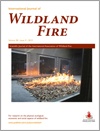International Journal of Wildland Fire
Volume 28
Number 9 2019
The wildland urban interface (WUI) can be subdivided into interface WUI - with many homes but relatively low amounts of wildland vegetation, and intermix WUI - where homes occur at lower densities within a wildland matrix. Of all buildings destroyed by California wildfires, half were in the interface WUI, while a third were in intermix WUI, highlighting the importance of models, mitigation and regulations that are tailored for the interface WUI.
A tower site selection optimisation framework that may be used to configure camera-based wildfire detection systems in vast, complex terrains is presented. The framework can obtain multiple practical layouts within days, allowing more rapid planning, deployment and activation of new systems compared with what has been possible with conventional methods.
Forestry machine operations ignite fires in certain regions. This study describes the extent, characteristics and underlying mechanisms of such fires in Sweden. The occurrence of large stones (typical for Swedish soils) is strongly associated with ignitions. Cancelling operations in stony terrain during high-risk weather situations can largely resolve the problem.
There is a critical need for policymakers to emphasise the benefits of physical training (PT) in reducing injuries and fatigue in wildland firefighters (WLFFs), as well as improving the WLFFs’ work capacity and the likelihood of being perceived by other WLFFs as a strong, dependable crew member.
We coupled wildfire spread and erosion prediction modelling to examine how fuel management can be used to mitigate potential fire impacts on soil erosion. Post-fire sediment delivery varied among and within fuel treatments, as a function of exceedance probability, time since fire, slope steepness, fire severity and vegetation type.
Laboratory experiments were undertaken in a large combustion wind tunnel to investigate the interactions between two obliquely intersecting lines of fire in dry eucalypt forest litter (mean bulk density 66 kg m−3), with and without wind. Strong interactions were observed with wind but little interaction was observed under calm conditions.





